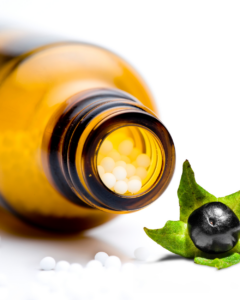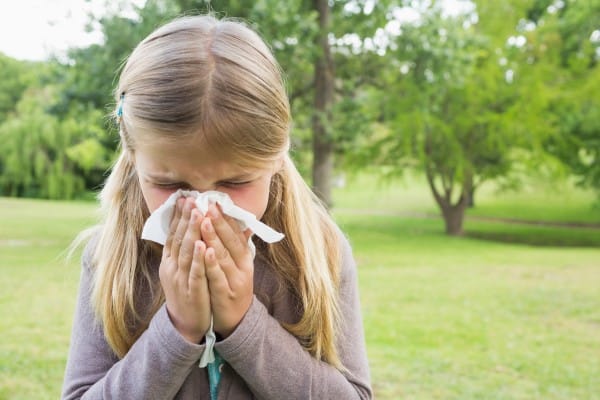Homeopathic remedies are one of my favorite ways to support the body through a fever without suppressing the fever itself. A well-selected remedy can speed up the healing process and provide almost immediate comfort. By choosing homeopathy we are able to support and comfort our children while allowing their bodies to act the way they were designed to.
This article covers 10 of my favorite homeopathic remedies for fever treatment, including key information and general dosing suggestions for each remedy, frequently asked questions about homeopathic remedies, and important information about when to seek medical attention for a fever.
Note: Studies have shown that suppressing fevers can potentially prolong illness (1,2). While we sometimes feel that over-the-counter (OTC) fever suppressors are necessary, we believe that trying natural ways to support the body through a fever is a preferred first approach.
Homeopathic Remedies Used For Fever Management
Below are some homeopathic remedies that may be useful in the treatment of your child’s fever. When selecting a remedy, keep in mind that homeopathy treats the whole person rather than simply one symptom. That means instead of only looking at the fever, you need to look at the whole array of symptoms. For example, you would want to note if your child is irritable and thirsty, or if they feel worse at different times of the day, as these symptoms would each point to different remedies.
Each remedy is listed with some key notes and general dosing suggestions. For best results, get advice from a healthcare provider who is familiar with homeopathic remedies. For more information about choosing a remedy and dosage, see this article: How to Use Homeopathic Remedies.
1. Aconitum Napellus (aka. Aconite, Acon)
Aconite is best used in the beginning stages of a sudden onset fever where the child presents as restless or thirsty. The symptoms may start after being exposed to dry, cold air or getting a chill. They will have a cold sweat and their cheeks may be red or pale.
Dosing notes: For best results, use Aconite 200 CH. Aconite is best given within the first 24 hours of symptom onset as it is less effective after that short time period.
2. Arsenicum Album (aka. Arsen alb, Ars)
This remedy would match best with a child who has a high temperature and is unable to keep warm. They only want small sips of water despite being very thirsty. They may alternate between feeling hot and chilly, which results in a sweat. Arsen alb is a great fit for a child who shows signs of anxiety during the fever as well.
Dosing notes: For best results, use Aresenicum Album 6C, 12C, or 30C.
Note: New research from 2024 shows that Aresenicum Album 30C modulates innate immunity through its actions on a type of white blood cell called macrophages (3). Macrophages play an important role in getting rid of the pathogens from our bodies and regulating other parts of the body’s immune system.
 3. Belladonna (aka. Bell)
3. Belladonna (aka. Bell)
Belladonna is used for the sudden onset of a high fever, where a child is not thirsty despite the mouth being dry. The child’s eyes may be glassy, the child may be delirious, and the child’s body will be hot to the touch everywhere except for their feet. They will also be very sensitive to sound as well as light and will prefer a dark, quiet room.
Dosing notes: For best results, use Belladonna 30C or 200C.
4. Chamomilla (aka. Chamomile, Cham)
Chamomilla is often used for a fever when a child is irritable and thirsty and wants to be comforted and held. There is restlessness and impatience. Often the face will be flushed on one side and the head will be hot. Covered parts of the body are often sweaty. The pain feels unbearable and it is worse before midnight.
Dosing notes: For best results, use Chamomilla 6C, 12C, or 30C.
5. Ferrum Phosphoricum (aka. Ferrum Phos, Ferr-P)
If a child has a sore throat or cold-like symptoms along with a fever, try Ferrum Phos. This is a good remedy for a child who has a mild fever with a rapid pulse. The child may get a chill that happens around 1PM every day. Their cheeks will be flushed and they will feel very tired. This fever tends to come on slowly.
Dosing notes: For best results, use Ferrum Phos 6C, 12C, or 30C.
6. Gelsemium Sempervirens (aka. Gelsemium, Gels)
Gelsemium is a good fit when a child’s fever is worse in the afternoon. It is accompanied by drowsiness and lack of thirst. The child may be breathing faster than normal and there may be alternating feelings of heat and cold up the back. This remedy is often a good choice when the child feels weak or dizzy.
Dosing notes: For best results, use Gelsemium 6C, 12C, or 30C.
7. Nux Vomica (aka. Nux V)
If a child is thirsty, has heavy arms and legs, is worse with movement, and wants to be in a warm bed covered with blankets, Nux Vomica would be a good option. This remedy is particularly helpful when stomach issues, such as indigestion and vomiting, are also present.
Dosing notes: For best results, use Nux Vomica 30C or 200C.
Note: An animal study showed that homeopathic Nux Vomica (200C or 1M) was able to reduce experimentally induced fever (4).
8. Oscillococcinum
Oscillococcinum is best to take when flu-like symptoms — such as body aches, headaches, and chills — accompany a fever.
Dosing notes: Oscillococcinum is used in a 200K dosage. It is best to take Oscillococcinum at the first sign of illness so it is most effective.
Note: Studies have shown that Oscillococcinum has reduced the severity and length of flu-like symptoms (5).
9. Pulsatilla (aka. Puls)
If your child is not showing signs of thirst and has a dry mouth and a fever that is worse at night, Pulsatilla would be a good option. A child that matches with Pulsatilla may also have a lack of appetite, an upset stomach, and a headache. Children who need pulsatilla tend to be clingy, moody, and weepy, and they feel much better with a cuddle.
Dosing notes: For best results, use Pulsatilla 30C or 200C.
10. Rhus Toxicodendron (aka. Rhus Tox, Rhus-T)
Rhus Tox would match best with a child who has a fever with body aches causing restlessness, especially when lying down. The child may feel hot and then cold and is often sweaty all over the body except for the head.
Dosing notes: For best results, use Rhus Tox 30C or 200C.
Homeopathic Remedy FAQs
Below are answers to some frequently asked questions regarding homeopathic remedies.
How Often Do I Dose A Remedy?
Dosing homeopathic remedies is usually individualized, but the following is the general guideline that I give my patients when treating fevers or other acute conditions:
Give the child the remedy and wait for 30 minutes to see if there is any improvement of symptoms (which may occur sooner).
- If symptoms improve, do not redose unless symptoms return. If the same symptoms return, redose the same remedy.* If new symptoms arise, you may need a different remedy.
- If symptoms don’t improve within 30 minutes, redose the remedy 1-2 more times. If symptoms still do not improve, you likely have an incorrect remedy and need to choose a different one.
With conventional fever reducers you may be advised to wake the child to redose the medication as needed. In contrast, when using homeopathic remedies for fevers, waking a child to redose a remedy is generally not recommended.
* You can redose the same remedy as often as every 30 minutes. If needing to redose more than 3-4 times in a day, consider that a different remedy may be needed.
 How Do I Know If A Remedy Is Working?
How Do I Know If A Remedy Is Working?
If a correct remedy was given, the child will usually show signs of improvement within the first 1-2 hours. This could include a normalization of body temperature, a reduction in other symptoms, and/or improved mood. Often this improvement in symptoms allows a child to rest and they will sleep well after taking a remedy, which is generally a good sign.
Can I Take Homeopathic Remedies With Other Fever Remedies?
Yes! Homeopathic remedies can be taken with other fever remedies, including herbal medicine, hydrotherapy, acupuncture, and conventional OTC fever reducers. It is best to space them out by at least 30 minutes to get the greatest results from the homeopathic remedies.
Are There Any Special Safety Considerations For Moms and Babies?
Yes! When giving homeopathic remedies to babies, dissolve the pellets in water first and administer a liquid dose. The pellets may be a choking hazard to infants who aren’t yet eating solid foods.
Additionally, do not use low potency remedies with small children; certain remedies like belladonna are toxic when not fully diluted and rare cases of toxicity have occurred (6). To avoid possible toxicity, stick to higher potency remedies (6C, 12C, 30C, 30X, and 200C) and always purchase from reputable companies.
It is my professional opinion that homeopathy is safe for pregnant and breastfeeding moms. Read this article for more details and other safety considerations: How To Use Homeopathic Remedies.
When To Consider Using OTC Fever Reducers
Natural fever reducers like homeopathics, herbs, and hydrotherapy are good first line treatments for fever, but there is a time and place for second line treatments, like acetaminophen or ibuprofen.
In general, I believe that over-the-counter (OTC) fever reducers should be used if natural remedies don’t provide adequate comfort to allow a child to rest and sleep. Additionally, if a fever is over 102°F/38.9°C for a child under 6 months or over 103°F/39.4°C for a child over 6 months and they aren’t responding to natural strategies to lower fever, then ibuprofen or tylenol are advised.
When To See A Doctor For Fever
Though many fevers are possible to treat at home with supportive care, there are times when medical care should be sought. Never delay seeking necessary medical attention while waiting to see if a homeopathic remedy will work.
Signs it is time to see a doctor for fever:
- Child is acting strangely or unlike themselves: child may be tired, irritable, or uninterested in playing
- Child appears seriously unwell
- Child is complaining of serious pain or discomfort
- Child has a stiff neck and/or sensitivity to light
- Child presents with signs of dehydration
- Fever in infant younger than 3 months old (if infant is younger than 1 month old, go to the emergency department)
- Fever lasts longer than 3-4 days
- Fever doesn’t respond to medication, including over-the-counter fever reducers
Summary
Homeopathy has been safely used for hundreds of years to help the body’s natural healing process. My top ten remedies for treating fevers are aconite, arsenicum album, belladonna, chamomilla, ferrum phosphoricum, gelsemium, nux vomica, oscillococcinum, pulsatilla, and rhus toxicodendron. Although many fevers are possible to treat at home with supportive care, never delay seeking necessary medical attention.
If you are looking for more ways to support a child with a fever, you may be interested in the following articles: The Wet Sock Treatment: A Home Remedy For Colds & Flus and Fever Management: Herbal Teas Safe in Childhood.
References:
- Cann S. A. H. (2021). Fever: Could A Cardinal Sign of COVID-19 Infection Reduce Mortality? The American journal of the medical sciences, 361(4), 420–426. https://www.ncbi.nlm.nih.gov/pmc/articles/PMC7833112
- Ludwig, J., & McWhinnie, H. (2019). Antipyretic drugs in patients with fever and infection: literature review. British journal of nursing (Mark Allen Publishing), 28(10), 610–618. https://pubmed.ncbi.nlm.nih.gov/31116598/
- Rath, S., Jema, J. P., Kesavan, K., Mallick, S., Pradhan, J., Chainy, G. B. N., Nayak, D., Kaushik, S., & Dandapat, J. (2024). Arsenic album 30C exhibits crystalline nano structure of arsenic trioxide and modulates innate immune markers in murine macrophage cell lines. Scientific reports, 14(1), 745. https://doi.org/10.1038/s41598-024-51319-w
- Ahmad, S., Rehman, T., & Abbasi, W. M. (2018). In vivo evaluation of antipyretic effects of some homeopathic ultra-high dilutions on Baker’s yeast-induced fever on Similia principle. Journal of Ayurveda and integrative medicine, 9(3), 177–182. https://pubmed.ncbi.nlm.nih.gov/29203352/
- Papp, R., Schuback, G., Beck, E., Burkard, G., Bengel, J., Lehrl, S., & Belon, P. (1998, April 1). OscillococcinumR in patients with influenza-like syndromes: A placebo-controlled double-blind evaluation. Science Direct. https://www.sciencedirect.com/science/article/abs/pii/S1475491699902084
- U.S. Food and Drug Administration (2017, January 27). FDA confirms elevated levels of belladonna in certain homeopathic teething products. FDA: U.S. Food & Drug Administration. https://www.fda.gov/news-events/press-announcements/fda-confirms-elevated-levels-belladonna-certain-homeopathic-teething-products







